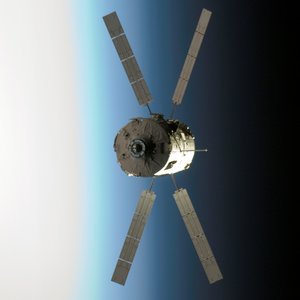Follow Jules Verne's last journey on the ESA website
Shortly after 15:30 CEST (13:30 UT) on Monday 29 September, ESA's Jules Verne Automated Transfer Vehicle will begin a controlled destructive re-entry high above an uninhabited area of the Pacific Ocean. Follow the final moments of this historic mission in ESA's ATV Blog.
Europe's first Automated Transfer Vehicle (ATV), named Jules Verne, undocked from the International Space Station on 5 September 2008, ending a highly successful mission to deliver supplies to the orbital outpost.
The ATV main engines will use their remaining fuel in two separate deorbit boosts to terminate the 3-week solo flight of Jules Verne. The deorbit boosts will send the 13.5-tonne spacecraft on a steep flight path initiating the controlled destructive re-entry high above the Pacific Ocean.
The planning of this event in the night time allows for observation from two aircrafts containing a collection of ESA and NASA scientific experiments allowing optical imaging and spectrometric observations. In addition, the ISS crew might be able to observe ATV re-entry with the Russian ultraviolet and spectrometric instrument, called FIALKA.
The re-entry will be monitored from ESA's ATV Control Centre in Toulouse, France. Throughout the day on Monday, the ATV Blog will carry regular updates from inside the ATV Control Centre.
See the ISS and ATV!
For those who are fortunate enough to live in the right area, and if the skies are cloud-free, there are currently some good ISS viewing opportunities across Europe - plus a last chance to see Jules Verne ATV in orbit before the re-entry. Consult the 'Heavens-Above' pages to find out if the ISS and ATV are currently visible at dawn and dusk where you live: Heavens-Above

















